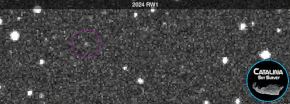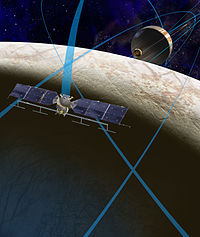2024 RW1
Appearance
 The sequence of four images in which 2024 RW1 (inside purple circles) was discovered | |
| Discovery[1][2] | |
|---|---|
| Discovered by | Jacqueline B. Fazekas |
| Discovery site | Mount Lemmon Obs. |
| Discovery date | 4 September 2024 |
| Designations | |
| 2024 RW1 | |
| CAQTDL2 | |
| NEO · Apollo | |
| Orbital characteristics[3] | |
| Epoch 4 September 2024 (JD 2460557.5) | |
| Uncertainty parameter 5 | |
| Observation arc | 10.30 h (618.23 min) |
| Aphelion | 4.279 AU |
| Perihelion | 0.735 AU |
| 2.507 AU | |
| Eccentricity | 0.7068 |
| 3.97 yr (1,450 d) | |
| 349.188° | |
| 0° 14m 53.799s / day | |
| Inclination | 0.528° |
| 162.457° | |
| 249.622° | |
| Earth MOID | 1.34283×10−5 AU (2.00885×103 km) |
| Physical characteristics[3][4] | |
| ~1 m (3.3 ft) | |
| C-type asteroid | |
| 32.048±0.343 | |
2024 RW1, previously known under its provisional designation CAQTDL2,[5] was a 1-meter-sized asteroid or meteoroid that struck the Earth's atmosphere and burned up harmlessly on September 5, 2024, at around 12:40 a.m. PHT (September 4, 16:40 UTC) above the western Pacific Ocean near Cagayan, Philippines.[5][6] 2024 RW1 is the ninth impact event that was successfully predicted,[7] which was discovered by Jacqueline Fazekas at NASA-funded Catalina Sky Survey.[8]
Ground observation
[edit]Despite the presence of Typhoon Yagi over the Philippines that the European Space Agency (ESA) initially said "might obscure the view of the asteroid", several observers reported seeing the fireball,[9] including those who posted videos on social media.[10]
See also
[edit]References
[edit]- ^ "2024 RW1". Minor Planet Center. Retrieved 6 September 2024.
- ^ "MPEC 2024-R68: 2024 RW1". Minor Planet Electronic Circular. Minor Planet Center. 4 September 2024. Retrieved 6 September 2024.
- ^ a b "(2024 RW1) – JPL Small-Body Database Lookup". ssd.jpl.nasa.gov. NASA / JPL. Retrieved 6 September 2024.
- ^ D. W. Green. "Electronic Telegram No. 5438" (TXT). Central Bureau for Astronomical Telegrams. Retrieved 5 September 2024.
- ^ a b M. Sparkes; J. Dinneen (4 September 2024). "A small asteroid hit Earth and burned up over the Philippines". New Scientist. Archived from the original on 4 September 2024. Retrieved 5 September 2024.
- ^ A. Reich (4 September 2024). "Asteroid the size of two house cats to hit Earth over the Philippines". The Jerusalem Post. Archived from the original on 5 September 2024. Retrieved 4 September 2024 – via MSN.
- ^ A. Kooser (4 September 2024). "Rare Asteroid Spotted Hours Before Impacting Earth's Atmosphere". Forbes. Archived from the original on 5 September 2024. Retrieved 5 September 2024.
- ^ B. Tingley (4 September 2024). "Tiny asteroid will hit Earth today, burn up over Philippines. 'Discovered this morning,' ESA says". Space.com. Archived from the original on 5 September 2024. Retrieved 4 September 2024.
- ^ "Asteroid '2024 RW1' burns up over the northeastern part of Luzon, PH". stii.dost.gov.ph. DOST. 12 September 2024. Retrieved 4 December 2024.
- ^ M. Bassi (4 September 2024). "An Asteroid Hit Earth's Atmosphere Today — Here's Why Astronomers Say That's a Good Thing". Smithsonian Magazine. Retrieved 5 September 2024.
External links
[edit]- 2024 RW1 at the JPL Small-Body Database
- Fireball observation 4885-2024 — list of eyewitness accounts of the fireball collected by the International Meteor Organization

